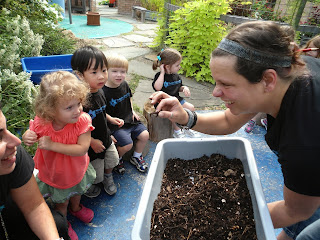The students understand that plants require soil, sun, and water to grow. They spent this week investigating how a plant grows.
First, the students told me what they know about plants. One girl said, "plants need time to grow". Another student said that he was watering his plant at home and it was growing. One student was excited to share that her tomato plant at home had already grown and "we picked a lot of tomatoes". Next they watched a video that showed the different stages in a plant's life cycle. They also saw a time-lapse video of seeds sprouting and growing into a sunflower.
First, the students told me what they know about plants. One girl said, "plants need time to grow". Another student said that he was watering his plant at home and it was growing. One student was excited to share that her tomato plant at home had already grown and "we picked a lot of tomatoes". Next they watched a video that showed the different stages in a plant's life cycle. They also saw a time-lapse video of seeds sprouting and growing into a sunflower.
After the video, the students used several types of resources to investigate and gain understanding. There were posters visually depicting the stages and each stage was numbered in order of sequence. We had several books, also. The most meaningful resource , of course, was the authentic example. The students had previously planted seeds and some of them were developing into plants. We observed several of the containers to determine which stage they were representing.
 To further enhance the experience, we uncovered several new plants and labeled the particular stage of growth.
To further enhance the experience, we uncovered several new plants and labeled the particular stage of growth.
To assess understanding, the students went out to search for different life cycle stages occurring in our garden. Among the discoveries were the seed head of an echinacea flower and new leaves on the beet sprouts.
























